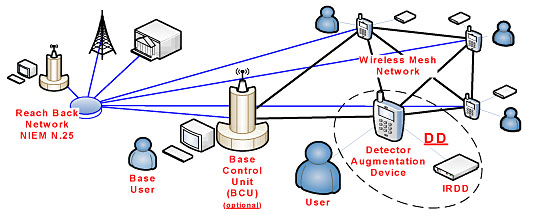The Countering Weapons of Mass Destruction (CWMD) Office was established in December 2017 by consolidating primarily the Domestic Nuclear Detection Office, a majority of the Office of Health Affairs, as well as other DHS elements.
For current information related to CWMD, please visit the following:
State, local and tribal law enforcement partners play a critical role in homeland security. The Domestic Nuclear Detection Office (DNDO) has developed the Intelligent Radiation Sensing System (IRSS) to better equip law enforcement to protect our cities from radiological or nuclear threats.
The Technology
The Intelligent Radiation Sensing System (IRSS) is a breakthrough technology that networks a group of portable radiation detectors. Using a networked system, the IRSS can determine with high confidence the presence, location and type of radiological material in an area more quickly and accurately than a group of individual detectors.
As displayed below (Figure 1.), the program must create a robust and flexible network architecture along with advanced data fusion algorithms that combine information from many detectors. A successful IRSS program could provide advanced search and monitoring capabilities across a large coverage area, and in difficult operational environments.
The IRSS technology can be used for a variety of other applications, such as ubiquitous monitoring, urban search, and locating and tracking moving sources using non-directional detectors.
Three vendors have developed Intelligent Radiation Sensing Systems. Two systems use base station dependent approaches; the other performs independent computation at each individual network node. All three investigated an array of fusion algorithms, and have developed their own detection, location, and identification capabilities.
Current Status
The Transformational and Applied Research (TAR) Directorate at DNDO expects to complete experiments to determine the performance capabilities of the IRSS systems by the end of April 2012. Highlighting a technology does not constitute an express or implied endorsement by the Government.

Figure 1. IRSS Wireless Mesh Network
